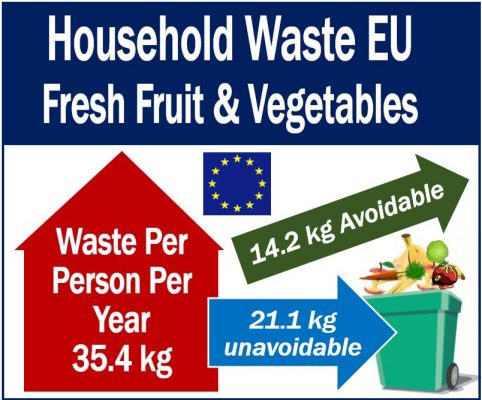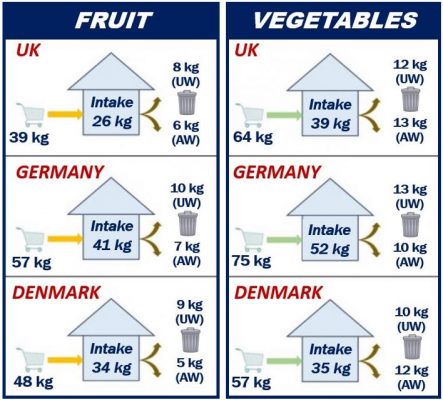EU households waste approximately 35.3 kg of fresh fruit and vegetables per person annually. About 40% of that waste, i.e., 14.2 kg, is avoidable, says the European Commission Joint Research Centre (JRC).
The FAO estimates that we don’t eat approximately one-third of all the food we produce globally. We don’t eat it because we either lose it or waste it. FAO stands for the Food and Agriculture Organization. It is a specialized agency of the United Nations that strives to defeat hunger.
National studies have calculated that nearly half of EU household’s food waste consists of fresh fruit and vegetables. This is not surprising, given that fresh fruit and vegetable make up about one-third of the food Europeans buy.
Some of the food waste must be thrown away because we cannot eat it. Orange peel and banana skins, for example, are inedible. Fresh fruit and vegetables are also relatively cheap and highly perishable.
Valeria De Laurentiis, Sara Corrado, and Serenella Sala work at the European Commission-Joint Research Centre. They carried out a study on household waste in the EU. They wrote about their study and findings in the journal Waste Management (citation below).

Reducing waste of fruit and vegetables
The authors said that it is possible to reduce the amount of avoidable waste with targeted prevention strategies.
It is also possible to manage the unavoidable waste more sustainably. We could manage the unavoidable waste at the manufacturing stage. We could then recycle it for use in the circular economy.
A ‘circular economy‘ is a regenerative one in which resource input and waste, energy leakage, and emissions are minimized.
The results of the study have implications for policies on the management of household food waste. They also have implications for policies on the prevention of food waste.
The researchers said their proposed model could help establish baseline practices regarding the differences in how much waste each country generates. It could help investigate the effects of various consumption patterns on waste generation.
The model could also estimate the reuse of unavoidable waste in various production systems.

Fresh food and vegetables – types of waste
The model can estimate how much of EU households’ avoidable and unavoidable waste consists of fruit and vegetables.
Unavoidable waste
Unavoidable waste consists of waste that arises from food preparation. It also consists of parts of the food that is not edible under normal circumstances.
Avoidable waste
Avoidable waste consists of food that was once edible before people threw it away.
Fifty-one types of fruit and vegetables
The researchers looked at 51 types of fresh fruit and vegetables in Germany, the UK, Finland, the Netherlands, Spain, and Denmark for 2010.
They gathered and analyzed the data to estimate how much avoidable and unavoidable waste EU households generated. Specifically, from the consumption of fresh fruit and vegetables.
The study found that per capita, EU residents generated 14.2 kg of avoidable and 21.1 kg of unavoidable waste annually.
Wasteful behaviors varied considerably
The researchers also found significant differences in wasteful behaviors. In other words, there were large differences in the unavoidable and avoidable waste that households in different countries generated.
The authors believe that the different wasteful behaviors were due to economic and cultural factors. They were also due to different consumption patterns.
In the UK, for example, purchases of fresh vegetables were lower than in Germany. However, the two countries’ generated about the same amount of unavoidable waste per capita. The amount of avoidable waste, however, was higher in the UK.
Avoidable waste was lower among people who spent a higher proportion of their income on food, the study showed.
Citation
“Quantifying household waste of fresh fruit and vegetables in the EU,” Valeria De Laurentiis, Sara Corrado, and Serenella Sala. Waste Management, Volume 77, July 2018, Pages 238-251. https://doi.org/10.1016/j.wasman.2018.04.001.
